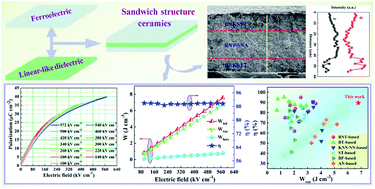Realizing superior energy storage properties in lead-free ceramics via a macro-structure design strategy†
Abstract
Based on the principle of sustainable development theory, lead-free ceramics are regarded as an excellent candidate in dielectrics for numerous pulsed power capacitor applications due to their outstanding thermal stability and environmental friendliness. However, the recoverable energy storage density (Wrec) and energy storage efficiency (η) of most lead-free ceramics are less than 4 J cm−3 and 80%, respectively, due to their low electric breakdown strength (Eb), large remnant polarization (Pr) and/or small maximum polarization (Pmax). In order to dramatically enhance the Wrec and η of lead-free ceramics, the macro-structure design strategy (construction of the ceramics with a sandwich structure comprising the large Pmax of ferroelectrics as the outer layer and the large Eb of the linear-like dielectric as the middle layer) was adopted to synergistically optimize the polarization and Eb in this study. Interestingly, the prepared ceramics exhibited a clear sandwich structure and the ultra-high Wrec of 6.78 J cm−3, together with a very high η of 89.7%, could be achieved at a high electric field of 572 kV cm−1, which are superior to the previously reported lead-free ceramics. Meanwhile, the energy storage properties also exhibited outstanding stability. In particular, the η was higher than 86% and the variation of Wrec was less than ±3% within 1–100 Hz and 30–120 °C. Therefore, the founding of this study opened up a novel and efficient guideline for exploring new environmentally friendly ceramics with superior energy storage properties.



 Please wait while we load your content...
Please wait while we load your content...